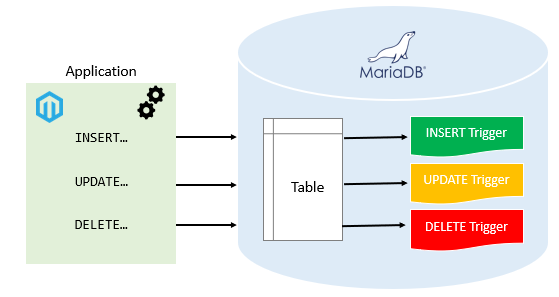Summary: in this tutorial, you will learn about MariaDB triggers and the main differences between triggers and stored procedures.
What is a trigger
A trigger is a stored database object that is automatically executed in response to a data modification event on a table.
The data modification events include insert, update, and delete caused by the insert, update, and delete statements.
MariaDB stored triggers as named objects in the data dictionary. A trigger is always associated with a table.
MariaDB trigger types
MariaDB supports the following types of triggers:
- The
inserttrigger is automatically executed when aninsertstatement adds a new row to a table. - The
updatetrigger is automatically fired when anupdatestatement modifies the data on a table. - The
deletetrigger is automatically invoked when adeletestatement removes one or more rows from a table.
MariaDB further classifies each type of trigger by trigger time including before and after:
- An
beforetrigger is fired right before an event occurs. For example, before theinsertevent occurs, you can validate the values that are being inserted. Typically, you use abeforetrigger for data cleansing and modification. - An
aftertrigger is invoked after an event occurs. Generally, you use an after trigger to keep audit trails.
When you combine the trigger time and event, you can have up to six triggers per table:
-
before insert -
after insert -
before update -
after update -
before delete -
after delete
Since MariaDB 10.2.3, you can define multiple triggers for the same trigger time (before and after) and trigger events (insert, update, and delete).

MariaDB executes a trigger for each row affected by the insert, update, and delete event. This trigger is called a row-level trigger.
If a trigger is fired solely based on the trigger event regardless of the number of rows affected, the trigger is called the statement-level trigger. Currently, MariaDB does not support statement-level triggers.
Triggers vs. stored procedures
Similar to stored procedures, triggers contain procedural code.
The following table displays the main differences between triggers and stored procedures:
| Characteristics | Triggers | Stored Procedures |
|---|---|---|
| Event-driven | Yes | No |
| Associated with a table | Yes | No |
| Return a result | No | Yes |
Managing triggers in MariaDB
- Create trigger – create a new trigger by using the
create triggerstatement. - Drop trigger – remove a trigger from the database using the
drop triggerstatement.
In this tutorial, you have learned about MariaDB triggers and the main differences between triggers and stored procedures.